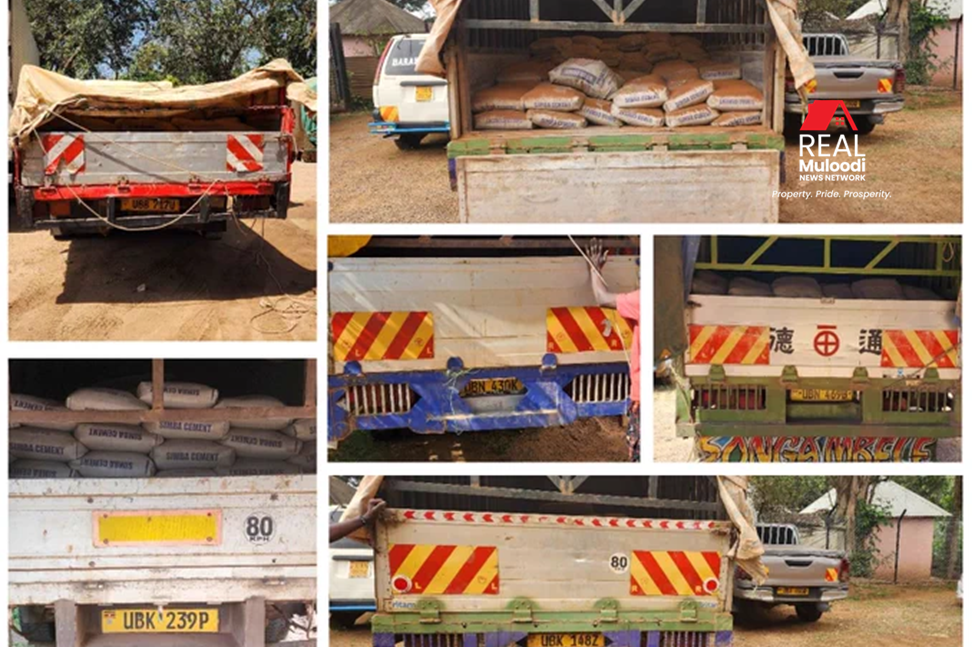UGANDA, Kampala | Real Muloodi News | In a bid to curb the surge in cement smuggling from Kenya, the Ugandan government, through the Uganda Revenue Authority (URA), has intensified surveillance and intelligence-led operations along the eastern border points.
The surge in cement smuggling from Kenya into Uganda has cast shadows on the country’s real estate sector and construction-related finances, influencing taxes and prices.
The illegal influx of cheap cement is not only affecting the market dynamics but also posing challenges to the revenue collection system.
Investigations exposed the illicit flow of cheap, illegal cement into Uganda through porous border areas, particularly on the Lwakhakha, Busia, and Malaba borders.
Both large and small-scale traders partake in this unlawful trade, utilising smaller vehicles to transport cement through uncontrolled border points.
URA’s spokesperson, Mr Ibrahim Bbosa, highlighted the Authority’s commitment to thwarting cement smuggling from Kenya. He pointed out a concerning increase in the trafficking of brands like Simba and Bamburi.
As a consequence, the real estate sector is experiencing disruptions, with smuggled cement being directly transported to construction sites.
Over the past two months, URA’s enforcement teams intercepted 3,286 bags of smuggled cement, equivalent to 164.3 metric tonnes.
In response to this challenge, credible informants have been engaged to provide timely information on smuggling activities.
Mr. Bbosa underscored that the smuggled cement is consolidated and transported by trucks to various destinations within Uganda.
The primary driver behind this illegal trade is the notable price difference between Ugandan and Kenyan cement.
Kenya offers cement at approximately KSh800 per bag (about USh19,200), significantly lower than Uganda’s prices.
Even with a USh4,200 tax per bag for traders with a certificate of origin, Kenyan cement remains more affordable.
Mr. Bbosa emphasised enhanced information sharing and coordination with government agencies at border points, including security and immigration departments.
Repeat offenders and individuals involved in smuggling activities will face prosecution.
Despite these measures, customs officials have reported high clearances of legally imported cement from Kenya at various border points. For instance, Lwakhakha Customs processed 224,604 bags, generating USh950 million in taxes this year.
Suam River Customs Border and Malaba Border also contributed significantly to tax revenue, with figures of USh148 million and USh45 million, respectively.
However, the government is losing revenue, as URA is supposed to collect USh2,000 per 50kg bag of cement entering the country.
The Uganda-Kenya border, stretching over 800 kilometres, poses challenges for effective monitoring, allowing smugglers to exploit porous areas and informal crossing points.
Mr Amos Mafabi, a businessman in Lwakhakha Town Council, described how the number of bags smuggled depends on the vehicle’s size, with bicycles, motorcycles, and vans being common carriers.
Other stakeholders, such as Mr. James Opolot, who runs a hardware retail shop in Malaba, expressed concerns about the impact on their businesses.
He lamented the impact on sales, noting a decline from selling around 200 bags per day to struggling to sell even 10 bags due to the direct ferrying of Kenyan cement to construction sites.
The direct ferrying of cheaper Kenyan cement to construction sites leaves local retailers with fewer customers, particularly in porous points like Buteba Sub County in Busia District.
Manufacturers and traders argue that weak enforcement systems contribute to the rise in smuggling. The smuggling often occurs even at gazetted borders, where smugglers allegedly bribe enforcement officers.
Tororo Cement’s CEO, Mr. Morgan Gagran, expressed concern on the negative economic impact cement smuggling has had on the local manufacturing industry highlighting instances where smugglers resort to stealing Tororo cement packaging bags to repackage their illicitly acquired cement.
This, he argued, could compromise the quality of construction materials available in the market.
Mr. Robert Awori, a business consultant, called for standardising product prices and criticised the unfair competition created by smuggling.
He argued against the imposition of higher prices for locally produced cement when Kenya, which imports electricity from Uganda, sells cement at a lower rate.
Some hardware dealers reportedly sell smuggled cement alongside Ugandan cement in their shops, potentially impacting the quality and standards of construction materials.
While the Tororo Resident District Commissioner, Mr. Nickson Owole, acknowledged the challenge of porous borders, he condemned the rising trend of smuggling.
The competition between locally produced cement and the influx of cheaper smuggled alternatives not only impacts market dynamics but also raises questions about the quality and standards of construction materials.
Stringent measures have been discussed, but the complexity of the border points poses a challenge to deployment, emphasising the need for enhanced operations to combat cement smuggling effectively.
READ MORE LIKE THIS:
Bamburi Cement Positions for Additional Gain in Uganda Unit Sale
Hima Cement: Holcim Divests Ugandan Cement Business to a Local Company
Cement: Types, Uses and Which is Right for Your Construction



